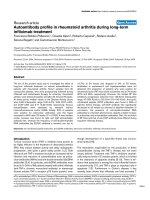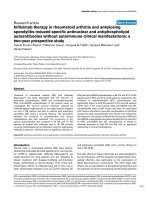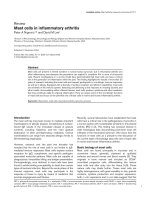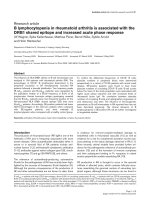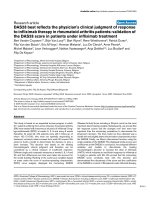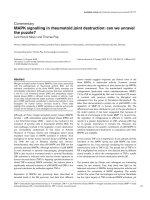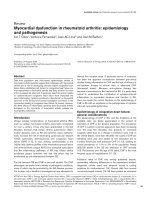Báo cáo y học: "Infliximab therapy in rheumatoid arthritis and ankylosing spondylitis-induced specific antinuclear and antiphospholipid autoantibodies without autoimmune clinical manifestations: a two-year prospective study" potx
Bạn đang xem bản rút gọn của tài liệu. Xem và tải ngay bản đầy đủ của tài liệu tại đây (187.58 KB, 9 trang )
Open Access
Available online />R535
Vol 6 No 6
Research article
Infliximab therapy in rheumatoid arthritis and ankylosing
spondylitis-induced specific antinuclear and antiphospholipid
autoantibodies without autoimmune clinical manifestations: a
two-year prospective study
Carole Ferraro-Peyret
1
, Fabienne Coury
1
, Jacques G Tebib
2
, Jacques Bienvenu
1
and
Nicole Fabien
1
1
UF Autoimmunité, Laboratoire d'Immunologie, Centre Hospitalier Lyon-Sud, Pierre Bénite, France
2
Service de Rhumatologie, Centre Hospitalier Lyon-Sud, Pierre Bénite, France
Corresponding author: Nicole Fabien,
Received: 22 Apr 2004 Revisions requested: 2 Jun 2004 Revisions received: 30 Jun 2004 Accepted: 29 Jul 2004 Published: 23 Sep 2004
Arthritis Res Ther 2004, 6:R535-R543 (DOI 10.1186/ar1440)
http://arthr itis-research.com/conte nt/6/6/R535
© 2004 Ferraro-Peyret et al.; licensee BioMed Central Ltd.
This is an Open Access article distributed under the terms of the Creative Commons Attribution License ( />2.0), which permits unrestricted use, distribution, and reproduction in any medium, provided the original work is cited.
Abstract
Treatment of rheumatoid arthritis (RA) with infliximab
(Remicade
®
) has been associated with the induction of
antinuclear autoantibodies (ANA) and anti-double-stranded
DNA (anti-dsDNA) autoantibodies. In the present study we
investigated the humoral immune response induced by
infliximab against organ-specific or non-organ-specific antigens
not only in RA patients but also in patients with ankylosing
spondylitis (AS) during a two-year followup. The association
between the presence of autoantibodies and clinical
manifestations was then examined. The occurrence of the
various autoantibodies was analyzed in 24 RA and 15 AS
patients all treated with infliximab and in 30 RA patients
receiving methotrexate but not infliximab, using the appropriate
methods of detection. Infliximab led to a significant induction of
ANA and anti-dsDNA autoantibodies in 86.7% and 57% of RA
patients and in 85% and 31% of AS patients, respectively. The
incidence of antiphospholipid (aPL) autoantibodies was
significantly higher in both RA patients (21%) and AS patients
(27%) than in the control group. Most anti-dsDNA and aPL
autoantibodies were of IgM isotype and were not associated
with infusion side effects, lupus-like manifestations or infectious
disease. No other autoantibodies were shown to be induced by
the treatment. Our results confirmed the occurrence of ANA and
anti-dsDNA autoantibodies and demonstrated that the induction
of ANA, anti-dsDNA and aPL autoantibodies is related to
infliximab treatment in both RA and AS, with no significant
relationship to clinical manifestations.
Keywords: ankylosing spondylitis, anti-β
2
-glycoprotein I autoantibodies, antiphospholipid autoantibodies, infliximab, rheumatoid arthritis.
Introduction
Clinical trials in rheumatoid arthritis (RA) have demon-
strated that antibodies directed against tumor necrosis fac-
tor α(TNF-α) (adalimumab, infliximab [Remicade
®
]) are
highly beneficial for most patients who are refractory to
classic treatment with disease-modifying anti-rheumatic
drugs, methotrexate or steroid therapy [1-4]. These anti-
inflammatory effects of infliximab have led to their use in
other inflammatory diseases such as Crohn's disease [5]
and ankylosing spondylitis (AS), with a similar efficacy to
that in RA [6-8].
The side effects of these treatments are acknowledged to
be very infrequent, with the exception of opportunistic intra-
cellular infection, due particularly to the reactivation of
latent Mycobacterium tuberculosis. The other major side
effects are an exacerbation of demyelinating disorders and
the induction of severe neutropenia and thrombocytopenia
ACL = anticardiolipin; ADA = anti-adrenal autoantibodies; AMA = anti-mitochondrial autoantibodies; ANA = antinuclear autoantibodies; ANCA = anti-
neutrophil cytoplasmic autoantibodies; aPL = antiphospholipid; AS = ankylosing spondylitis; dsDNA = double-stranded DNA; ELISA = enzyme-linked
immunosorbent assay; ENA = anti-extractible nuclear antigen; β
2
GPI = β
2
-glycoprotein I autoantibodies; GPL = G phospholipid; IIF = indirect immun-
ofluorescence; LKM = anti-liver kidney microsomes; MPL = M phospholipid; RA = rheumatoid arthritis; SLE = systemic lupus erythematosus; SMA
= anti-smooth muscle; TG = anti-thyroglobulin; TNF-α = tumor necrosis factor α; TPO = thyroid peroxidase.
Arthritis Research & Therapy Vol 6 No 6 Ferraro-Peyret et al.
R536
[1,2,4,9-11]. Infusion reactions have also been observed
and have been correlated with the induction of anti-chi-
meric antibodies against infliximab [12]. The development
of autoantibodies that are usually associated with systemic
lupus erythematosus (SLE), namely antinuclear (ANA) and
anti-double-stranded DNA (anti-dsDNA) autoantibodies,
has also been observed after infliximab treatment in 63.8%
and 13% of RA patients and in 49.1% and 21.5% of
Crohn's disease patients, respectively [13-15]. Among the
sera that were positive for anti-dsDNA autoantibodies, 9%
were also positive for anti-Sm autoantibodies, which are
specific for SLE [13]. However, only a few cases of SLE-
like syndrome have been reported in infliximab-treated
patients [9,13,16-18].
As yet, the occurrence of other autoantibodies has not
been clearly demonstrated, such as antiphospholipid (aPL)
autoantibodies and anti-β
2
-glycoprotein I (anti-β
2
GPI)
autoantibodies, which are often associated with SLE
[19,20], or autoantibodies associated with vasculitis,
autoimmune hepatitis or autoimmune endocrine diseases,
which have been reported in therapy that interferes with
cytokine balance [21].
In the present study we investigate the prevalence of such
autoantibodies during 2 years of follow-up in patients with
RA or AS successfully treated with infliximab. The aim of
the study was to discover whether the humoral response
induced by infliximab is restricted to non-organ specific
autoantibodies and to identify any associated clinical pres-
entations, with the aim of monitoring their occurrence by
detecting these autoantibodies. Concurrently, 30 patients
whose RA was controlled only by methotrexate were ana-
lyzed at 1-year intervals as controls for autoantibody
production.
Materials and methods
Patient sera
Twenty-four patients with RA and 15 patients with AS, ful-
filling the ACR criteria [22] and the modified New York cri-
teria [23], respectively, were monitored for autoantibody
production over a 2-year period during which they were
good responders, as defined by the modified disease activ-
ity scores [24], to a combination of methotrexate and inflix-
imab. Concurrently, 30 RA patients well controlled by
methotrexate for 6–15 years (mean 12 years) gave blood
samples at 1-year intervals as controls for autoantibody
production. Demographic and clinical statuses are pre-
sented in Table 1. Patients were followed clinically by the
same physician during this period at regular intervals and in
particular when they were receiving infliximab infusions.
Clinical assessment (painful and swollen joint count, spine
stiffness, careful examination of side effects, significant
concomitant clinical features suggestive of infections or
autoimmune disorders) were recorded accurately (Table
1). Nine patients discontinued infliximab treatment before
the end of the study, between 3 and 18 months, because
of adverse events, treatment inefficacy or severe infectious
disease. Further details are given in Table 1.
Treatment protocol
Twenty-four RA and 15 AS patients were treated with inf-
liximab (Centocor, Malvern, PA, USA). In RA patients, inflix-
imab was administered in accordance with the schedule of
the ATTRACT phase III clinical trials [4]. Patients were
given infliximab at a dose of 3 mg/kg at 0, 2, 4 and 6 weeks
and thereafter every 8 weeks. In AS patients, after the initial
6-week protocol with 5 mg/kg, infliximab was delivered
every 6 or 8 weeks, depending on the clinical response.
When AS patients presented a remission, the timing of infu-
sions was dictated by disease relapse [25].
Follow-up of autoantibodies
Tests for autoantibodies were performed at baseline before
the start of infliximab treatment and during the 24-month
duration of infliximab treatment as indicated below. The
sera of the 30 control RA patients were analyzed twice with
a 1-year interval.
Detection of ANA
Tests for ANA were performed at the start of infliximab
treatment and at 6, 12, 18 and 24 months, by an indirect
immunofluorescence technique (IIF) using HEp2 cells (Bio-
Rad, Marnes-la-Coquette, France). Sera were diluted 1:80
and the conjugate was a goat anti-human F(ab')
2
IgG, A, M
(H+L) antibody conjugated to fluorescein isothiocyanate
(diluted 1:100) (Bio-Rad). Classic titration of each ANA
positive at a titer of 1:80 was performed by serial dilutions
to 1:5120. A titer equal to or greater than 1:160 was inter-
preted as a positive result. For positive sera that had
nuclear granular or cytoplasmic staining, the identification
of autoantibodies against (ENA) was further investigated by
enzyme-linked immunosorbent assay (ELISA) with an anti-
human IgG (H+L) conjugate (Biomedical Diagnostics,
Marne-la-Vallée, France).
Detection of anti-dsDNA autoantibodies
Tests for anti-dsDNA autoantibodies were performed at the
start of infliximab treatment and, depending on the forma-
tion of ANA, at 6, 12, 18 and 24 months of treatment with
the use of a radioimmunological test (Dade Behring, Paris,
France) in accordance with the manufacturer's instructions.
A titer equal or greater than 5 IU/ml was interpreted as a
positive result. For positive sera, the anti-dsDNA autoanti-
body isotype was determined by ELISA (Pharmacia,
Freiburg, Germany) with an anti-human IgG (H+L) (Bio-
Rad) or an anti-human IgM (H+L) (Dako) conjugate.
Detection of anti-smooth muscle (SMA), anti-
mitochondrial (AMA), anti-liver kidney microsomes
Available online />R537
(LKM), anti-thyroid peroxidase (TPO), anti-thyroglobulin
(TG) and anti-adrenal (ADA) autoantibodies
Tests for SMA, AMA, LKM, TPO, TG and ADA autoantibod-
ies were performed at the start of infliximab treatment and
then at 3, 6, 12, 18 and 24 months. The sera of the 30 con-
trol RA patients were analyzed twice with a 1-year interval.
For SMA, AMA, LKM and ADA, sera diluted 1:30 were
tested on mouse stomach, kidney, liver or adrenal sections
(Biomedical Diagnostics), with the same technique as
described for ANA. For TPO and TG autoantibodies, an
ELISA technique was performed in accordance with the
manufacturer's instructions with an anti-human IgG (H+L)
conjugate (Pharmacia, Saint-Quentin-en-Yvelines, France).
Detection of anti-neutrophil cytoplasmic autoantibodies
(ANCA)
Tests for ANCA were performed at the start of infliximab
treatment and then after 6 and 12 months. The sera of the
30 control RA patients were analyzed twice with a 1-year
interval. The sera diluted 1:20 were tested by IIF on human
neutrophils fixed in ethanol (Menarini Diagnostics, Antony,
France) with the same technique as for ANA. Positive sera
were further tested for reactivity against myeloperoxidase
and proteinase 3 by using an ELISA with an anti-human IgG
(H+L) conjugate (Bioadvance, Emerainville, France). Titers
were considered positive when they were 20 arbitrary units
(AU)/ml or more.
Detection of aPL and anti-β
2
GPI autoantibodies
Investigation of aPL autoantibodies was performed by the
detection of anticardiolipin autoantibodies (ACL). ACL and
anti-β
2
GPI autoantibodies were evaluated at baseline and
at 6, 12 and 24 months after the start of infliximab treat-
ment. The sera of the 30 control RA patients were analyzed
twice with a 1-year interval. ACL were detected with an
ELISA in accordance with the manufacturer's instructions
by using anti-human IgG (H+L) or IgM (H+L) conjugates.
Values were expressed as arbitrary G phospholipid (GPL)
or M phospholipid (MPL) units. Positive results were
graded as low positivity (IgG 11–23 GPL, IgM 6–10 MPL),
Table 1
Clinical characteristics of patients
Control Rheumatoid arthritis Ankylosing spondylitis
Number of patients 30 24 15
Mean age, years (range) 63 (30–83) 56 (26–77) 41 (26–57)
Number of women (%) 23 (76.7) 16 (66.7) 4 (26.7)
Disease duration, years (range) 7.4 (1–22) 12 (3–32) 17 (6–30)
Infliximab treatment (mg/kg) 0 3 5
Concomitant medication
Number of patients with
NSAID 22 10 5
Corticosteroids 19 19 8
Methotrexate 30 24 6
Side effects
Number of patients with
Allergy 3 M
a
, 1 S
a
1 S
a
Infections 2 M
a
, 2 S
a
2 M
a
, 1 S
a
Other (amyloidosis) 0 3 M
a
Inefficacy of treatment
Number of patients 2 2
Months 8 and 10 Months 5 and 7
AS, ankylosing spondylitis; NSAID, non-steroidal anti-inflammatory drugs; RA, rheumatoid arthritis.
a
Significant side effects and inefficacy that could lead to infliximab discontinuation. If side effects were severe (S), infliximab was stopped; thus
nine patients discontinued infliximab treatment before the end of the study, between 3 and 18 months in 5 RA and 2 AS patients. If moderate (M),
infliximab was continued. The severe infections were pulmonary tuberculosis (RA), septic pericarditis (AS) and Streptococcus bovis endocarditis
(RA). Two severe anaphylactic reactions during infliximab infusion (1 RA, 1 AS) led to discontinuation of treatment and in one case (RA) required
resuscitation. Three patients with severe long-standing AS were suspected of amyloidosis at the start of infliximab treatment because of nephritic
proteinuria. The diagnosis was confirmed by renal biopsy and the infusion carried out.
Arthritis Research & Therapy Vol 6 No 6 Ferraro-Peyret et al.
R538
moderate positivity (IgG 24–39 GPL, IgM 11–29 MPL) or
high positivity (IgG ≥ 40 GPL, IgM ≥ 30 MPL). The anti-
β
2
GPI autoantibodies were detected by using a home-
made assay previously described [26] with serum samples
diluted 1:50 and peroxidase-conjugated anti-human IgG
(H+L) or IgM (H+L) (Cappell, ICN Biomedicals, OH, USA)
diluted 1:400. Positive results were graded as low positivity
for a value from a ratio of 1.2–1.9 AU/ml (attenuance ['opti-
cal density'] of the sample divided by attenuance of the cut-
off), moderate positive for a value of ratio between 2 and 3
AU/ml and high positive for a value superior to a ratio of 3
AU/ml. The cut-off was determined by using the mean plus
5 standard deviations of attenuance of 100 sera from blood
donors (data not shown).
Statistics
Statistical analysis (95% and 99% confidence interval) was
performed with the χ
2
test when applicable and with
Fisher's exact test in other conditions.
Ethics
Written informed consent was obtained from all patients
and the study was approved by the Research and Ethics
Committee of the Hospices Civils de Lyon.
Results
Occurrence of ANA and anti-dsDNA autoantibodies in
RA and AS patients
At baseline, 9 of 24 (37.5%) infliximab-treated RA patients,
2 of 15 (13.3%) AS patients and 5 of 30 (16.7%) control
RA patients were tested positive for ANA (Table 2). After
12 months of therapy, the induction of ANA was observed
in 12 infliximab-treated RA patients, 8 AS patients and 4
control RA patients. At that time, the total number of posi-
tive ANA patients was 21 of 24 (87.5%) for infliximab-
treated RA patients, 10 of 15 (66.7%) AS patients and 9 of
30 (30%) control RA patients. The difference between the
number of induced ANA compared with the number of pos-
itive ANA at baseline was statistically significant (P <
0.0001) for infliximab-treated RA and AS patients, whereas
the difference was not significant for the RA control group.
The difference in induction was also significant for the inf-
liximab-treated RA patients (P < 0.0001) comparing the
two RA groups.
After 2 years of infliximab therapy, ANA became positive in
one other infliximab-treated RA patient and three more AS
patients, giving a total induction of 87% in RA and 85% in
AS. The induction of ANA appeared between 3 and 18
months (mean 6.35 months) for RA and between 3 and 24
months (mean 10.6 months) for AS. Except in two RA
patients, all the induced ANA were still positive at the end
of the study, including in eight of nine patients who discon-
tinued the treatment. One RA became negative 3 months
after the end of the treatment. Furthermore, in six of the nine
sera of infliximab-treated RA patients positive at baseline,
the ANA titer increased up to twofold (data not shown). The
titer of ANA showed a higher level between the positive
ANA at the baseline compared with the titer of induced
ANA, but the difference was not significant. In most ANA-
positive sera during infliximab treatment, the pattern of
staining was homogeneous. Two of the 22 infliximab-
treated RA ANA-positive sera had granular nuclear staining
characteristic of ENA. The specific target could not be
identified with the use of the classic ELISA kit for ENA
detection.
For anti-dsDNA autoantibodies, 1 of 24 infliximab-treated
RA patients (4.2%), 2 of 15 AS patients (13.3%) and none
of the control RA patients were positive at baseline (Table
2). After 12 months of treatment, induction of anti-dsDNA
autoantibodies was observed in 10 of 23 (46.5%) inflixi-
mab-treated RA patients, 3 of 13 (23%) AS patients and 2
of 30 (6.7%) control patients. The induction was observed
between 3 and 12 months. Three further infliximab-treated
RA patients and one further AS patient became positive at
18 and 24 months, respectively, giving a total induction of
57% in RA and 31% in AS.
After the 2-year follow-up, the total number of positive
patients was 14 of 24 (58.33%) for infliximab-treated RA
patients, 6 of 15 (40%) for AS patients and 2 of 30 (6.7%)
for control RA patients. All patients who became positive
for anti-dsDNA autoantibodies were also positive for ANA.
All the induced anti-dsDNA autoantibodies remained posi-
tive until the end of the study, including in three of four pos-
itive patients who discontinued the treatment. One RA
patient became negative 3 months after the end of the
treatment. The difference between the number of induced
anti-dsDNA autoantibodies and the number of positive anti-
dsDNA autoantibodies at baseline was statistically signifi-
cant for the infliximab-treated RA patients (P < 0.0001) and
for the infliximab-treated AS patients (P < 0.02) compared
with the RA control group. Comparing the two RA groups,
the difference in induction was also significant for the inflix-
imab-treated RA patients (P < 0.0001). The titer of anti-
dsDNA autoantibodies showed a higher level between the
positive autoantibodies at baseline compared with the
induced autoantibodies. The formation of ANA and anti-
dsDNA autoantibodies was not linked to clinical events,
namely infectious side effects, allergy or lack of efficacy.
Occurrence of aPL/ACL and anti-β
2
GPI autoantibodies in
RA and AS patients
At baseline, no RA or AS patients were positive for ACL or
for anti-β
2
GPI autoantibodies. At the end of the study, sig-
nificant levels of ACL were found in infliximab-treated RA
patients (5 of 24, P < 0.01) and in infliximab-treated AS
patients (4 of 15, P < 0.01) compared with the RA control
group (Table 3).
Available online />R539
Induction of anti-β
2
GPI autoantibodies was observed in 2
of 24 infliximab-treated RA patients and in none of the con-
trol RA patients (Table 3). The difference was not signifi-
cant between the two RA populations nor within the RA
and AS group, comparing the number of induced autoanti-
bodies at baseline and after treatment. In infliximab-treated
RA patients, sera were positive for ACL or anti-β
2
GPI
autoantibodies (Table 3). In the group of AS patients, the
two induced sera were positive for both ACL and anti-
β
2
GPI autoantibodies.
All ACL and anti-β
2
GPI autoantibodies were from patients
positive for ANA. Five of 11 ACL or anti-β
2
GPI autoanti-
body-positive sera were positive for anti-dsDNA autoanti-
bodies. Induction did not occur simultaneously and did not
seem to be determined by clinical events. Two AS sera
positive for anti-dsDNA autoantibodies at baseline became
positive for ACL autoantibodies 6 and 10 months after the
beginning of treatment. For the other sera, anti-dsDNA,
ACL and anti-β
2
GPI autoantibodies developed between 6
and 12 months after the start of treatment. No correlation
was found between the occurrence of side effects (includ-
ing infections), clinical status (including lupus-like symp-
Table 2
Detection of ANA and anti-dsDNA autoantibodies during infliximab treatment
Number of positive sera ANA Anti-dsDNA autoantibodies
Infliximab RA (n = 24) n
0
91
n
i12
12 10
n
i24
13 13
n
t
22 14
Infliximab AS (n = 15) n
0
22
n
i12
83
n
i24
11 4
n
t
13 6
Control RA (n = 30) n
0
50
n
i12
42
n
t
92
ANA, antinuclear autoantibodies; anti-dsDNA, anti-double-stranded DNA autoantibodies; n
0
, number of positive sera before treatment; n
i12
,
number of positive sera-induced autoantibodies after 12 months of treatment; n
i24
, number of positive sera-induced autoantibodies after 24
months of treatment; n
t
, number of positive sera before treatment plus number of induced autoantibodies during infliximab treatment.
Table 3
Detection of ACL and anti-β2GPI autoantibody-positive sera during infliximab treatment
Number of positive sera Anti-β
2
GPI autoantibodies
a
aCL autoantibodies
b
IgG IgM IgG IgM
Infliximab, RA (n = 24) n
0
0000
n
t
21
c
05
Infliximab, AS (n = 15) n
0
0000
n
t
0231
Control, RA (n = 30) n
0
0000
n
t
0000
Anti-β
2
GPI, anti-β
2
-glycoprotein I autoantibodies; aCL, anticardiolipin autoantibodies; n
0
, number of positive sera before treatment; n
t
, number of
positive sera before treatment plus number of induced autoantibodies during infliximab treatment.
a
Anti-β
2
GPI with one high titer (5.4 AU/ml [IgG], 5 AU/ml [IgM]) and one moderate titer (2.1 AU/ml [IgG]), in 2 of 15 AS with two high titers (8.7
AU/ml [IgG], 3.4 AU/ml [IgM]).
b
Low, moderate and high titers were observed in two patients (15.1, 23 G phospholipid), in six patients (22.4, 22.8, 15.4, 21, 22.1 M
phospholipid, 27 G phospholipid), and in one patient (41.5 M phospholipid) respectively.
c
Both IgG and IgM.
Arthritis Research & Therapy Vol 6 No 6 Ferraro-Peyret et al.
R540
toms, thrombopenia or thrombosis) and anti-β
2
GPI or ACL
autoantibodies.
Isotypes of induced anti-dsDNA, aPL/ACL and anti-β
2
GPI
autoantibodies in RA and AS patients
Most of the anti-dsDNA autoantibodies detected during inf-
liximab treatment of RA patients, of AS patients and in the
control RA population were of IgM isotype (11 of 13 [85%],
4 of 4 [100%] and 2 of 2 [100%] respectively). One of the
sera from infliximab-treated RA patients and one from AS
patients were positive for both IgG and IgM. Two sera in the
infliximab-treated RA group were positive only for IgG. The
presence of the IgG isotype was not associated with any
particular clinical pattern such as infections, lupus-like syn-
drome or side effects of infusion.
Among the ACL, five of five infliximab-treated RA patients
and one of four AS patients were of IgM isotype. Three AS
patients were of IgG isotype. The isotypes of the positive
anti-β
2
GPI autoantibodies were IgM and IgG (one case),
IgG (one case) for RA and IgM or IgG for AS. As for the IgG
isotype in induced anti-dsDNA autoantibodies, no signifi-
cant clinical association was observed in patients present-
ing the IgG ACL and/or anti-β
2
GPI autoantibody profile.
Occurrence of TPO, TG, AMA, LKM, SMA, ADA and ANCA
autoantibodies
Three of the 24 (12.5%) infliximab-treated RA patients, 6 of
30 (20%) control RA patients and no AS patients had TPO
or TG autoantibodies at baseline. Patients with RA
remained positive during infliximab treatment and at the 1-
year intervals of methotrexate treatment. Only one patient
(1 of 21, 4.8%) in the infliximab-treated RA group devel-
oped both TPO and TG autoantibody positivity after 12
months of treatment.
One of 24 infliximab-treated RA patients (4.2%) and 2 of
15 AS patients (13.3%) who were negative at baseline
became positive for ANCA as determined by IIF. The target
of these ANCA was identified by ELISA as proteinase 3 for
two sera (25 and 40 AU/ml) and both myeloperoxidase and
proteinase 3 for one serum (45 and 30 AU/ml). For the RA
control group, ANCA were observed in two patients at
baseline and remained positive at 1 year. The target of
these ANCA was neither proteinase 3 nor myeloperoxi-
dase. No other patient developed such autoantibodies after
the 1-year interval analysis.
Three of the 24 infliximab-treated RA patients (12.5%) and
2 of 30 RA controls (6.7%) were SMA positive at baseline.
Three of 21 infliximab-treated RA sera (14.3%) and 2 of 15
AS sera (13.3%) that were negative at baseline became
positive for SMA autoantibodies at 1.5, 3, 6, 3 and 6
months respectively. These SMA autoantibodies were not
antiactin autoantibodies, the only autoantibodies that are
specific for autoimmune hepatitis.
Neither RA nor AS patients developed AMA, LKM or ADA
autoantibodies.
The occurrence of TPO, TG, ANCA, AMA, LKM, SMA or
ADA autoantibodies during infliximab therapy was not sta-
tistically significant.
Discussion
The occurrence of a large panel of autoantibodies that are
considered as biological markers of various autoimmune
diseases has been investigated in a population of RA and
AS patients treated with infliximab for 2 years, the longest
period described so far for this kind of management. To
avoid the bias of spontaneous autoantibody production
under methotrexate, a control population of RA patients
treated only with methotrexate was analyzed in parallel at 1-
year intervals.
ANA, anti-dsDNA and aPL were the only autoantibodies to
be significantly induced by infliximab treatment in RA and
AS patients. This induction has already been described for
ANA and anti-dsDNA autoantibodies [13,27] but our study
demonstrates for the first time that infliximab treatment can
also induce aPL autoantibodies in both RA and AS
patients.
Our observation of ANA in up to 91.7% and 86.7% of RA
and AS patients, respectively, after infliximab therapy is
consistent with recent data published during the course of
the present study [27]. However, the occurrence of anti-
dsDNA autoantibodies was higher in our study for both RA
and AS [27,28]. These discrepant results may be due to
the longer period of our analysis. Indeed, the previous study
analyzed this occurrence for 8.5 months after the initiation
of infliximab treatment [27]; we found that anti-dsDNA
autoantibodies can be induced after this period, the latest
induction being found 24 months after the onset of inflixi-
mab treatment.
Clinical monitoring of the patients did not show any symp-
toms characteristic of SLE in the subgroup that was posi-
tive for ANA/anti-dsDNA autoantibodies.
Antiphospholipid autoantibodies were induced in 21% (5
of 24) and 27% (4 of 15) of our RA and AS patients,
respectively. Anti-β
2
GPI autoantibodies were induced in
8% and 13% of our RA and AS patients, respectively. Until
now, the induction of such autoantibodies has not been
described in patients treated with infliximab therapy. How-
ever, it has been demonstrated in a single study in 5 of 8
(63%) RA patients treated with etanercept [29]. In that
study, the presence of aPL autoantibodies along with anti-
Available online />R541
dsDNA autoantibodies was concomitant with several infec-
tions [29]. In our study, we also found an association
between anti-dsDNA and aPL autoantibodies but clinical
monitoring of the patients did not show any relationship
between a particular serological profile and the occurrence
of infection, thrombosis or thrombocytopenia for the aPL
autoantibody-positive subgroup.
In contrast with other studies showing aPL autoantibodies
in RA and AS populations, we found no aPL autoantibodies
at baseline [30-32]. Most of the studies reporting a high
frequency of aPL autoantibodies were conducted with non-
standard tests; furthermore, the titers of most of the posi-
tive sera were very low. The difference in sensitivity might
also be due to the choice of a different cut-off of positivity
for the aPL autoantibody test and to the different clinical
characteristics of the patients analyzed. Thus, the ACL test
is not specific with low-positive results, so we chose a high
cut-off for this test [33].
The induction of ANA and aPL autoantibodies was clearly
due to infliximab, especially in the RA group, because no
such induction was observed in the control RA group
treated with methotrexate alone. The mechanisms that
underlie autoantibody development during infliximab treat-
ment are intriguing. These autoantibodies do in fact occur
in a variety of disorders, such as RA, AS and Crohn's dis-
ease, which are characterized by different physiopatholog-
ical mechanisms and different doses of infliximab. One can
then postulate that this particular induction is due to the
partial blockage of TNF-α induced by infliximab therapies.
The role of the disturbance of the cytokine network in such
induction has already been demonstrated for another
cytokine, interferon γ, inducing the development of autoan-
tibodies in patients with hepatitis C viral infection or RA
[21,34,35].
Induction of autoantibodies could be a predictable conse-
quence of anti-TNF-α blockade because this blockade
could promote humoral autoimmunity by inhibiting the
induction of cytotoxic T lymphocyte response, which nor-
mally suppresses autoreactive B-cells [36]. Infliximab might
also act by neutralizing the biological activity of TNF-α by
binding the soluble forms of TNF-α, thereby preventing the
interaction of TNF-α with its cellular receptors, p55 and
p75. Infliximab also binds the transmembrane form of TNF-
α and could induce antibody-dependent or complement-
dependent cellular cytotoxicity of the cells expressing the
cytokine [37]. Furthermore, infliximab has been shown to
increase the number of apoptotic T lymphocytes in the lam-
ina propria [38] and apoptotic monocytes in peripheral
blood in Crohn's disease [39]. In this case, one hypothesis
concerning the development of autoimmune diseases such
as SLE is that an increased apoptotic process could pro-
mote the release of numerous autoantigens, leading to the
development of autoantibodies against cytoplasmic and
nuclear compounds such as ANA and dsDNA [40], espe-
cially if production of these autoantibodies is no longer
suppressed by the action of infliximab on the suppressor T
cell population. This apoptotic process might not occur in
organ-specific cells because these cells, namely thyro-
cytes, do not harbor TNF-α receptor, thus shedding some
light on the findings concerning the absence of organ-spe-
cific autoantibodies associated with autoimmune vasculitis,
hepatitis or endocrine diseases.
Like Charles and colleagues [13], we demonstrated that
most of the anti-dsDNA autoantibodies detected during the
treatment of RA with infliximab were of IgM isotype. Further-
more, we showed that most of the detected aPL autoanti-
bodies were also of IgM isotype. The role of these IgM in
the development of autoimmune diseases remains to be
elucidated. Natural autoreactive IgM autoantibodies might
suppress autoimmunity by inducing B cell tolerance and
thus by participating in the negative selection of autoreac-
tive B cells. The larger pool of autoantibodies of IgM iso-
type observed during infliximab treatment might be the
consequence of a higher production of natural autoreactive
IgM, but might also be an induced population that can fur-
ther switch to IgG with a well-known pathogenic effect. A
high frequency of IgM might also result from TNF blockade,
as it was demonstrated in a murine model of collagen-
induced arthritis that anti-TNF-α monoclonal antibodies
reduce isotype switching to IgG in the local draining lymph
node [41].
Conclusion
Our results show that infliximab induces ANA, anti-dsDNA
and aPL autoantibodies at various times after the start of
treatment. However, it seems that the development of such
autoantibodies is not predictive of the development of SLE-
like syndrome, because during the 2-year follow-up of
infliximab therapy no APL syndrome or SLE syndrome
appeared. Nevertheless, these findings do not exclude the
possibility that such pathology might develop after a longer
period of infliximab treatment. They underline the need to
monitor the humoral response, namely autoantibodies and
clinical manifestations, in patients treated with infliximab
over a longer period.
Competing interests
None declared.
Acknowledgements
We thank MC Letroublon and all the biological technicians of the labo-
ratory for their technical assistance.
References
1. Bathon JM, Martin RW, Fleischmann RM, Tesser JR, Schiff MH,
Keystone EC, Genovese C, Wasko MC, Moreland LW, Weaver
AW, et al.: A comparison of etanercept and methotrexate in
Arthritis Research & Therapy Vol 6 No 6 Ferraro-Peyret et al.
R542
patients with early rheumatoid arthritis. N Engl J Med 2000,
343:1586-1593.
2. Elliott MJ, Maini RN, Feldmann M, Kalden JR, Antoni C, Smolen JS,
Leeb B, Breedveld FC, Macfarlane JD, Bijl H: Randomised dou-
ble-blind comparison of chimeric monoclonal antibody to
tumour necrosis factor alpha (cA2) versus placebo in rheuma-
toid arthritis. Lancet 1994, 344:1105-1110.
3. Illei G, Lipsky PE: Novel, non-antigen-specific therapeutic
approaches to autoimmune/inflammatory diseases. Curr Opin
Immunol 2000, 12:712-718.
4. Lipsky PE, Van der Heijde DM, St Clair EW, Furst DE, Breedveld
FC, Kalden JR, Smolen JS, Weisman M, Emery P, Feldmann M, et
al.: Infliximab and methotrexate in the treatment of rheumatoid
arthritis. Anti-Tumor Necrosis Factor Trial in Rheumatoid
Arthritis with Concomitant Therapy Study Group. N Engl J Med
2000, 343:1594-1602.
5. Present DH, Rutgeerts P, Targan S, Hanauer SB, Mayer L, Van
Hogezand RA, Podolsky DK, Sands BE, Braakman T, DeWoody
KL, et al.: Infliximab for the treatment of fistulas in patients with
Crohn's disease. N Engl J Med 1999, 340:1398-1405.
6. Brandt J, Haibel H, Cornely D, Golder W, Gonzalez J, Reddig J,
Thriene W, Sieper J, Braun J: Successful treatment of active
ankylosing spondylitis with the anti-tumor necrosis factor
alpha monoclonal antibody infliximab. Arthritis Rheum 2000,
43:1346-1352.
7. Braun J, Brandt J, Listing J, Zink A, Alten R, Golder W, Gromnica-
Ihle E, Kellner H, Krause A, Schneider M, et al.: Treatment of
active ankylosing spondylitis with infliximab: a randomised
controlled multicentre trial. Lancet 2002, 359:1187-1193.
8. Van den Bosch F, Kruithof E, Baeten D, De Keyser F, Mielants H,
Veys EM: Effects of a loading dose regimen of three infusions
of chimeric monoclonal antibody to tumour necrosis factor
alpha (infliximab) in spondyloarthropathy: an open pilot study.
Ann Rheum Dis 2000, 59:428-433.
9. Antoni C, Braun J: Side effects of anti-TNF therapy: current
knowledge. Clin Exp Rheumatol 2002, 20:S152-S157.
10. Day R: Adverse reactions to TNF-alpha inhibitors in rheuma-
toid arthritis. Lancet 2002, 359:540-541.
11. Vidal F, Fontova R, Richart C: Severe neutropenia and thrombo-
cytopenia associated with infliximab. Ann Intern Med 2003,
139:W-W63.
12. Baert F, Noman M, Vermeire S, Van Assche G, D'Haens G, Car-
bonez A, Rutgeerts P: Influence of immunogenicity on the long-
term efficacy of infliximab in Crohn's disease. N Engl J Med
2003, 348:601-608.
13. Charles PJ, Smeenk RJ, De Jong J, Feldmann M, Maini RN:
Assessment of antibodies to double-stranded DNA induced in
rheumatoid arthritis patients following treatment with inflixi-
mab, a monoclonal antibody to tumor necrosis factor alpha:
findings in open-label and randomized placebo-controlled
trials. Arthritis Rheum 2000, 43:2383-2390.
14. Hanauer SB: Review article: safety of infliximab in clinical trials.
Aliment Pharmacol Ther 1999, 13:16-22.
15. Vermeire S, Noman M, Van Assche G, Baert F, Van Steen K, Esters
N, Joossens S, Bossuyt X, Rutgeerts P: Autoimmunity associ-
ated with anti-tumor necrosis factor alpha treatment in
Crohn's disease: a prospective cohort study. Gastroenterology
2003, 125:32-39.
16. Markham A, Lamb HM: Infliximab a review of its use in the man-
agement of rheumatoid arthritis. Drugs 2000, 59:1341-1359.
17. Shakoor N, Michalska M, Harris CA, Block JA: Drug-induced sys-
temic lupus erythematosus associated with etanercept
therapy. Lancet 2002, 359:579-580.
18. Sarzi-Puttini P, Ardizzone S, Manzionna G, Atzeni F, Colombo E,
Antivalle M, Carrabba M, Bianchi-Porro G: Infliximab-induced
lupus in Crohn's disease: a case report. Dig Liver Dis 2003,
35:814-817.
19. Galli M, Barbui T: Prevalence of different anti-phospholipid
antibodies in systemic lupus erythematosus and their rela-
tionship with the antiphospholipid syndrome. Clin Chem 2001,
47:985-987.
20. Sinico RA, Bollini B, Sabadini E, Di Toma L, Radice A: The use of
laboratory tests in diagnosis and monitoring of systemic lupus
erythematosus. J Nephrol 2002, 15(Suppl 6):S20-S27.
21. Corssmit EP, Heijligenberg R, Hack CE, Endert E, Sauerwein HP,
Romijn JA: Effects of interferon-alpha (IFN-alpha) administra-
tion on leucocytes in healthy humans. Clin Exp Immunol 1997,
107:359-363.
22. Arnett FC, Edworthy SM, Bloch DA, McShane DJ, Fries JF, Cooper
NS, Healey LA, Kaplan SR, Liang MH, Luthra HS: The American
Rheumatism Association 1987 revised criteria for the classifi-
cation of rheumatoid arthritis. Arthritis Rheum 1988,
31:315-324.
23. Van der Linden S, Valkenburg HA, Cats A: Evaluation of diagnos-
tic criteria for ankylosing spondylitis. A proposal for modifica-
tion of the New York criteria. Arthritis Rheum 1984, 27:361-368.
24. Prevoo MLL, van't Hof MA, Kuper HH, van Leeuwen MA, van de
Putte LBA, van Riel PLCM: Modified disease activity scores that
include twenty-eight-joint counts: development and validation
in a prospective longitudinal study of patients with rheumatoid
arthritis. Arthritis Rheum 1995, 38:44-48.
25. Temekonidis TI, Alamanos Y, Nikas SN, Bougias DV, Georgiadis
AN, Voulgari PV, Drosos AA: Infliximab therapy in patients with
ankylosing spondylitis: an open label 12 month study. Ann
Rheum Dis 2003, 62:1218-1220.
26. Reber G, Schousboe I, Tincani A, Sanmarco M, Kveder T, de Moer-
loose P, Boffa MC, Arvieux J: Inter-laboratory variability of anti-
beta2-glycoprotein I measurement. A collaborative study in
the frame of the European Forum on Antiphospholipid Anti-
bodies Standardization Group. Thromb Haemost 2002,
88:66-73.
27. De Rycke L, Kruithof E, Van Damme N, Hoffman IE, Van den Boss-
che N, Van den Bosch F, Veys EM, De Keyser F: Antinuclear anti-
bodies following infliximab treatment in patients with
rheumatoid arthritis or spondylarthropathy. Arthritis Rheum
2003, 48:1015-1023.
28. Louis M, Rauch J, Armstrong M, Fitzcharles MA: Induction of
autoantibodies during prolonged treatment with infliximab. J
Rheumatol 2003, 30:2557-2562.
29. Ferraccioli G, Mecchia F, Di Poi E, Fabris M: Anticardiolipin anti-
bodies in rheumatoid patients treated with etanercept or con-
ventional combination therapy: direct and indirect evidence for
a possible association with infections. Ann Rheum Dis 2002,
61:358-361.
30. Vittecoq O, Jouen-Beades F, Krzanowska K, Bichon-Tauvel I,
Menard JF, Daragon A, Gilbert D, Tron F, Le Loet X: Prospective
evaluation of the frequency and clinical significance of
antineutrophil cytoplasmic and anticardiolipin antibodies in
community cases of patients with rheumatoid arthritis. Rheu-
matology (Oxford) 2000, 39:481-489.
31. Bonnet C, Vergne P, Bertin P, Treves R, Jauberteau MO:
Antiphospholipid antibodies and RA: presence of β
2
GP1 inde-
pendent aCL. Ann Rheum Dis 2001, 60:303-304.
32. Juanola X, Mateo L, Domenech P, Bas J, Contreras N, Nolla JM,
Roig-Escofet D: Prevalence of antiphospholipid antibodies in
patients with ankylosing spondylitis. J Rheumatol 1995,
22:1891-1893.
33. Harris EN, Pierangeli SS: Revisiting the anticardiolipin test and
its standardization. Lupus 2002, 11:269-275.
34. Graninger WB, Hassfeld W, Pesau BB, Machold KP, Zielinski CC,
Smolen JC: Induction of systemic lupus erythematosus by
interferon-gamma in a patient with rheumatoid arthritis. J
Rheumatol 1991, 18:1621-1622.
35. Ploix C, Verber S, Chevallier-Queyron P, Ritter J, Bousset G, Mon-
ier JC, Fabien N: Hepatitis C virus infection is frequently asso-
ciated with high titers of anti-thyroid antibodies. Int J
Immunopathol Pharmacol 1999, 12:121-126.
36. Via CS, Shustov A, Rus V, Lang T, Nguyen P, Finkelman FD: In
vivo neutralization of TNF-alpha promotes humoral autoim-
munity by preventing the induction of CTL. J Immunol 2001,
167:6821-6826.
37. Zimmermann-Nielsen E, Agnholt J, Thorlacius-Ussing O, Dahlerup
JF, Baatrup G: Complement activation in plasma before and
after infliximab treatment in Crohn disease. Scand J
Gastroenterol 2003, 38:1050-1054.
38. Ten Hove T, van Montfrans C, Peppelenbosch MP, van Deventer
SJ: Infliximab treatment induces apoptosis of lamina propria T
lymphocytes in Crohn's disease. Gut 2002, 50:206-211.
39. Lugering A, Schmidt M, Lugering N, Pauels HG, Domschke W,
Kucharzik T: Infliximab induces apoptosis in monocytes from
patients with chronic active Crohn's disease by using a cas-
pase-dependent pathway. Gastroenterology 2001,
121:1145-1157.
Available online />R543
40. Bell DA, Morrison B: The spontaneous apoptotic cell death of
normal human lymphocytes in vitro: the release of, and immu-
noproliferative response to, nucleosomes in vitro. Clin Immu-
nol Immunopathol 1991, 60:13-26.
41. Campbell IK, O'Donnell K, Lawlor KE, Wicks IP: Severe inflam-
matory arthritis and lymphadenopathy in the absence of TNF.
J Clin Invest 2001, 107:1519-1527.
